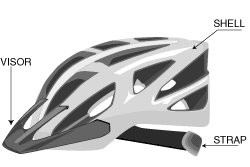Cycling Helmets
Your helmet is the most important piece of equipment you can buy. Make sure to choose one that's right for you.
How To Buy A Cycling Helmet
Proper protection is important for all cyclers, no matter what type of bike you are riding. A proper fitting helmet can prevent most serious head injuries. However, your helmet will do you no good if it does not fit properly.
Choosing the Right Helmet
You should wear a helmet every time you ride. In many states helmets are mandatory for children under a certain age, usually 14 years old. Be sure that your helmet fits comfortably and correctly, and check that it is certified for impact protection.
Helmet Types
Bike helmets are available in four styles: sport, road, BMX and mountain bike. All are designed to be light, comfortable and protect against impact.
Sport Helmets
- Are good for all-around use
- Usually value-priced
Road Cycling Helmets
- These helmets are designed to be as lightweight as possible
- Usually the construction consists of a plastic shell, foam padding and a chin strap
- These helmets often include large vents for air circulation and to cut down on weight
BMX Helmets
- These helmets tend to offer more coverage around the back and sides of the head and sometimes include face protection
- Generally BMX helmets are larger and strong than cycling helmets
- These helmets are intended for use on rough terrain
Mountain Bike Helmets
- Mountain bike helmets offer maximum protection during off-road use
Helmet Design Features
- Liner
- Helmet liners are made of expanded polystyrene foam that is designed to crush and crack on impact, so your head won't
- Shell
- Helmet shells are made of polyethylene plastic and are designed to hold the helmet together during a crash, as well as protect your head from sharp objects such as branches and rocks
- Shells also allow the helmet to skid on impact, which decreases friction and protects you from more serious injury
- Ventilation
- Helmet vents enhance airflow over and around your head, which helps you stay cool and comfortable as you ride
- The more vents a helmet has, the cooler it will be
- Straps
- Also called a retention system
- When fastened properly straps keeps the helmet in place
- Straps will vary in thickness depending on style
- Generally, mountain bike helmets have thicker straps to contend with the extra bouncing and jostling of off-road riding; road helmets have lighter, thinner straps for coolness
- All straps should be adjusted so that there is no slack. The chin strap should be solidly buckled and up against the throat.
- Some straps include pinch-preventing buckles that help prevent the user from pinching their necks when they are securing the helmet
- Custom Fit Adjustments
- Many top of the line helmets have an easy to grab mechanism that allows you to adjust the fit and comfort level of your helmet anytime you need to, even during your ride
- Hair port
- A special design in the strap system to accommodate a ponytail
- Visor
- Visors are handy for both shielding against glare and for deflecting airflow from your eyes
- Many helmet models have removable snap-on visors and are made out of plastic or foam
- Weight
- Although less of a concern for mountain biking than for road riding, lighter is better. It is also more expensive.
- Helmets weights are listed in grams and ounces
- Safety certification
- By law, all helmets sold in the U.S. must meet standards set by the Consumer Products Safety Commission (CPSC)
- Look for additional certification that the helmet meets standards set by the American Society for Testing and Materials (ASTM) or the Snell Foundation, generally regarded as the industry's toughest
Determining Your Head Size
- Helmets come in a variety of sizes and are usually measured in inches
- To ensure your safety it is important that your helmet fits properly

Care Tips
- Avoid suspending your helmet from handlebars or brake levers. This may cause accidental dents and scratches.
- It is best to keep your helmet on your head even during short rest stops. When not wearing your helmet, keep it in a protected area such as a shelf or closet.
- It is best to store your helmet in the box in which it came or a nylon gear bag
- Do not toss your helmet in the back seat or trunk of a car, especially on hot days. The helmet may be damaged if it rolls or is subjected to high temperatures.
- Do not use petroleum-based solvents or automotive wax to clean or polish your helmet. These chemicals may destroy the helmet. Always use water-soluble cleansers.
- Helmets with worn or frayed straps should be replaced.